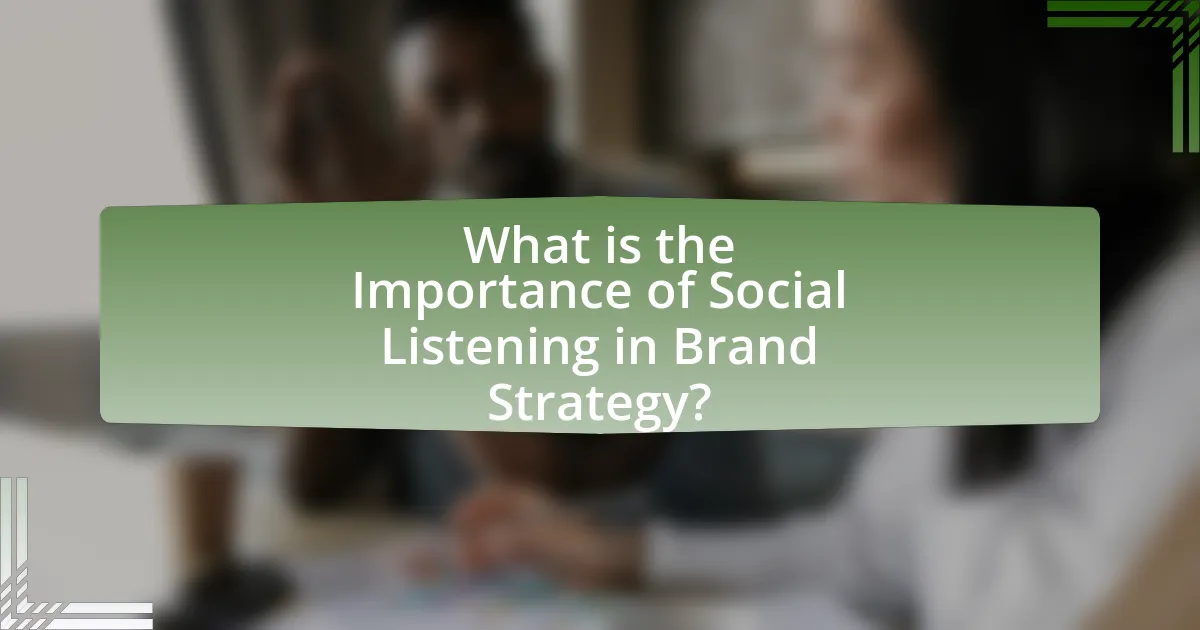Social listening is a critical component of brand strategy, enabling companies to gauge consumer sentiments, preferences, and trends in real-time through monitoring social media and online conversations. This practice enhances brand awareness, customer engagement, and loyalty by allowing brands to respond effectively to feedback and adapt their marketing strategies accordingly. The article explores the tools used for social listening, the metrics for measuring customer sentiment, and the challenges brands face in implementing these strategies. Additionally, it highlights the importance of ethical considerations and future trends in social listening, emphasizing its role in competitive analysis and market trend identification.

What is the Importance of Social Listening in Brand Strategy?
Social listening is crucial in brand strategy as it enables companies to understand consumer sentiments, preferences, and trends in real-time. By monitoring social media platforms and online conversations, brands can gather insights that inform product development, marketing strategies, and customer engagement efforts. For instance, a study by Sprout Social found that 70% of consumers are more likely to recommend a brand that responds to their social media inquiries, highlighting the impact of active listening on customer loyalty and brand reputation. This data underscores the necessity of integrating social listening into brand strategy to enhance responsiveness and relevance in a competitive market.
How does social listening contribute to brand awareness?
Social listening significantly enhances brand awareness by allowing companies to monitor and analyze conversations about their brand across social media platforms. This practice enables brands to identify customer sentiments, preferences, and trends, which can inform marketing strategies and improve engagement. For instance, a study by Sprout Social found that 70% of consumers are more likely to recommend a brand that actively listens to feedback on social media. By leveraging insights gained from social listening, brands can create targeted content that resonates with their audience, ultimately increasing visibility and recognition in the market.
What tools are used for effective social listening?
Effective social listening tools include Hootsuite, Brandwatch, Sprout Social, and Mention. These platforms enable brands to monitor social media conversations, track brand mentions, and analyze sentiment. For instance, Brandwatch provides advanced analytics and insights from millions of online sources, allowing brands to understand public perception and trends. Hootsuite offers a comprehensive dashboard for managing multiple social media accounts and tracking engagement metrics. Sprout Social includes features for social media monitoring and reporting, helping brands refine their strategies based on real-time data. Mention allows users to receive alerts for brand mentions across various platforms, ensuring timely responses to customer feedback.
How can social listening improve customer engagement?
Social listening can improve customer engagement by enabling brands to understand customer sentiments and preferences in real-time. By monitoring social media platforms and online conversations, brands can identify trends, respond to customer inquiries promptly, and tailor their marketing strategies to align with customer needs. Research indicates that companies utilizing social listening tools experience a 20% increase in customer satisfaction, as they can address issues proactively and foster a sense of community. This direct interaction not only enhances brand loyalty but also encourages customers to share their positive experiences, further amplifying engagement.
Why is social listening essential for understanding customer sentiment?
Social listening is essential for understanding customer sentiment because it enables brands to monitor and analyze conversations about their products and services in real-time. By tracking social media platforms, brands can gather insights into customer opinions, preferences, and emotions, which are crucial for tailoring marketing strategies. Research indicates that 70% of consumers are more likely to recommend a brand that listens and responds to their feedback, highlighting the direct correlation between social listening and customer loyalty. This data-driven approach allows companies to adapt quickly to changing sentiments, ensuring they remain relevant and responsive to their audience’s needs.
What metrics are used to measure customer sentiment through social listening?
Metrics used to measure customer sentiment through social listening include sentiment analysis scores, volume of mentions, engagement rates, and share of voice. Sentiment analysis scores quantify positive, negative, or neutral sentiments expressed in social media posts, providing a clear indication of customer feelings. The volume of mentions tracks how often a brand is discussed, which correlates with customer interest and sentiment trends. Engagement rates measure interactions such as likes, shares, and comments, reflecting the level of customer involvement and sentiment towards the brand. Share of voice compares a brand’s mentions to competitors, offering insights into market perception and sentiment relative to others in the industry. These metrics collectively provide a comprehensive view of customer sentiment, enabling brands to adjust their strategies effectively.
How does customer sentiment influence brand strategy?
Customer sentiment significantly influences brand strategy by guiding decision-making and shaping marketing approaches. Brands analyze customer feedback, reviews, and social media interactions to understand consumer perceptions and preferences. For instance, a study by Sprout Social found that 70% of consumers are more likely to support brands that actively listen to their feedback. This data indicates that brands that adapt their strategies based on customer sentiment can enhance customer loyalty and improve overall brand reputation.
What role does social listening play in competitive analysis?
Social listening plays a critical role in competitive analysis by enabling brands to monitor and analyze conversations about competitors in real-time. This practice allows companies to gain insights into competitor strengths, weaknesses, and customer perceptions, which can inform strategic decision-making. For instance, a report by Sprout Social indicates that 70% of consumers are more likely to buy from a brand that actively listens to their feedback, highlighting the importance of understanding competitor engagement strategies. By leveraging social listening tools, brands can identify market trends, customer sentiment, and emerging threats, ultimately enhancing their competitive positioning.
How can brands leverage social listening to identify market trends?
Brands can leverage social listening to identify market trends by analyzing consumer conversations and sentiments across social media platforms. This analysis allows brands to detect emerging topics, preferences, and pain points among their target audience. For instance, a study by Nielsen found that 77% of consumers are more likely to buy from brands that engage with them on social media, indicating that active listening can reveal valuable insights into consumer behavior and preferences. By utilizing social listening tools, brands can track mentions, hashtags, and keywords related to their industry, enabling them to adapt their strategies in real-time based on the data collected.
What insights can be gained from monitoring competitors’ social media?
Monitoring competitors’ social media provides insights into their audience engagement strategies, content performance, and market positioning. By analyzing the types of posts that generate the most interaction, brands can identify effective messaging and content formats. For instance, a study by Sprout Social found that 70% of consumers are more likely to engage with brands that respond to their social media inquiries, highlighting the importance of responsiveness in audience engagement. Additionally, monitoring competitors allows brands to spot emerging trends and shifts in consumer preferences, enabling them to adapt their strategies accordingly. This competitive intelligence can inform product development, marketing campaigns, and overall brand positioning in the marketplace.
How can brands implement social listening effectively?
Brands can implement social listening effectively by utilizing advanced analytics tools to monitor conversations across social media platforms. These tools enable brands to track mentions, sentiment, and trends related to their products or services in real-time. For instance, a study by Sprout Social found that 70% of consumers are more likely to recommend a brand that responds to their social media inquiries, highlighting the importance of timely engagement. By analyzing this data, brands can gain insights into customer preferences and pain points, allowing them to tailor their marketing strategies accordingly. Additionally, integrating social listening into regular reporting processes ensures that insights are consistently applied to improve customer experience and brand reputation.
What are the best practices for integrating social listening into brand strategy?
The best practices for integrating social listening into brand strategy include establishing clear objectives, selecting appropriate tools, and analyzing data effectively. Establishing clear objectives ensures that the social listening efforts align with specific brand goals, such as improving customer engagement or enhancing product development. Selecting appropriate tools, such as Hootsuite or Brandwatch, allows brands to monitor relevant conversations and trends effectively. Analyzing data effectively involves not only gathering insights but also translating them into actionable strategies, which can lead to improved customer satisfaction and brand loyalty. According to a report by Sprout Social, 70% of consumers are more likely to recommend a brand that listens and responds to their feedback, highlighting the importance of integrating social listening into brand strategy.
How can brands ensure they are listening to the right conversations?
Brands can ensure they are listening to the right conversations by utilizing advanced social listening tools that analyze relevant keywords, sentiment, and audience demographics. These tools help brands identify conversations that align with their target market and brand values, allowing them to focus on discussions that matter most. For instance, a study by Sprout Social found that 70% of consumers feel more connected to brands that engage in meaningful conversations, highlighting the importance of targeting the right discussions. By continuously monitoring these conversations and adjusting their strategies based on real-time data, brands can effectively engage with their audience and enhance their brand strategy.
What challenges do brands face in social listening?
Brands face several challenges in social listening, primarily including data overload, sentiment analysis accuracy, and resource allocation. Data overload occurs when brands collect vast amounts of unstructured data from various social media platforms, making it difficult to identify relevant insights. Sentiment analysis accuracy is another challenge, as automated tools may misinterpret context, sarcasm, or cultural nuances, leading to incorrect conclusions about consumer sentiment. Additionally, resource allocation becomes a concern, as brands must invest time and personnel to effectively monitor and analyze social media conversations, which can strain budgets and operational capacity. These challenges highlight the complexities brands encounter in leveraging social listening for strategic decision-making.
How can brands overcome data overload in social listening?
Brands can overcome data overload in social listening by implementing advanced analytics tools that prioritize relevant data and automate insights extraction. These tools utilize machine learning algorithms to filter noise and identify key trends, allowing brands to focus on actionable insights rather than sifting through vast amounts of information. For instance, a study by Gartner indicates that organizations using AI-driven analytics can reduce data processing time by up to 70%, enabling quicker decision-making and more effective brand strategies.
What ethical considerations should brands keep in mind while listening socially?
Brands should prioritize user privacy and consent while engaging in social listening. This means obtaining explicit permission from individuals before collecting or analyzing their data, as mandated by regulations like the General Data Protection Regulation (GDPR). Additionally, brands must ensure transparency about how they use the information gathered, fostering trust and accountability. Ethical social listening also involves avoiding manipulation or exploitation of consumer sentiments, which can lead to negative brand perception. By adhering to these principles, brands can maintain ethical integrity and build stronger relationships with their audience.
What are the future trends in social listening for brand strategy?
Future trends in social listening for brand strategy include the integration of artificial intelligence and machine learning to enhance data analysis, real-time sentiment tracking, and the use of predictive analytics to anticipate consumer behavior. These advancements allow brands to gain deeper insights into customer preferences and market dynamics. For instance, a report by Gartner indicates that by 2025, 75% of organizations will invest in AI-driven social listening tools, reflecting a significant shift towards data-driven decision-making in brand strategies. Additionally, the rise of voice and visual search will necessitate brands to adapt their social listening approaches to capture diverse content formats and platforms, ensuring they remain relevant in an evolving digital landscape.
How will advancements in technology impact social listening practices?
Advancements in technology will significantly enhance social listening practices by enabling real-time data analysis and improved sentiment detection. Technologies such as artificial intelligence and machine learning allow brands to process vast amounts of social media data quickly, identifying trends and consumer sentiments with greater accuracy. For instance, AI-driven tools can analyze text, audio, and visual content across multiple platforms, providing insights that were previously unattainable. According to a report by Gartner, organizations that leverage AI for social listening can improve their customer engagement strategies by up to 30%, demonstrating the tangible benefits of these technological advancements.
What emerging platforms should brands focus on for social listening?
Brands should focus on platforms like TikTok, Discord, and Clubhouse for social listening. TikTok’s rapid growth and user engagement provide insights into trends and consumer sentiment, while Discord offers a unique space for community discussions and brand interactions. Clubhouse, with its audio-based format, allows brands to gauge real-time conversations and opinions. These platforms are increasingly influential, with TikTok reaching over 1 billion users and Discord hosting millions of active communities, making them essential for effective social listening strategies.
What practical tips can brands follow to enhance their social listening efforts?
Brands can enhance their social listening efforts by implementing the following practical tips: First, utilize advanced social listening tools that aggregate data from various platforms, enabling brands to capture a comprehensive view of consumer sentiment. For instance, tools like Brandwatch and Sprout Social provide analytics that help brands identify trends and key topics of discussion. Second, establish clear objectives for social listening, such as improving customer service or identifying product feedback, which allows brands to focus their efforts effectively. Research indicates that 70% of brands that set specific goals for social listening report improved customer engagement. Third, engage with consumers directly by responding to comments and feedback, which fosters a sense of community and trust. According to a study by Hootsuite, brands that actively engage with their audience see a 20% increase in customer loyalty. Lastly, regularly analyze and adjust strategies based on insights gathered from social listening, ensuring that brands remain responsive to changing consumer needs and preferences.




